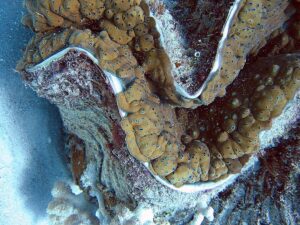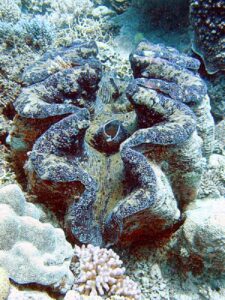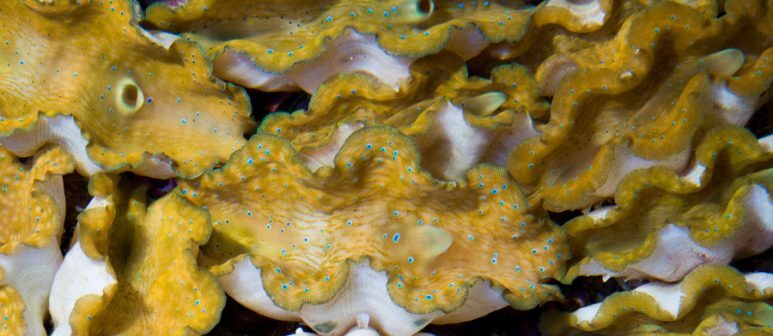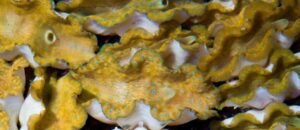There is something almost archetypal in the legend of man-eating clams. Perhaps this evokes allegorical imagery of a greedy or overly plucky sort of fool that meets their demise while attempting to steal a pearl from its ‘mouth?’ To highlight how persistent this image is in popular culture, consider that the U.S. Navy Diving Manual once provided instructions for escaping monster clams by cutting the adductor muscles that close the shell. We won’t even get into the cheesy aquarium ornaments from our childhoods that played on this same theme…
These tales appear to have come from early (and yes, likely uneventful) encounters with the giant clam Tridacna gigas. It’s worth noting here that all of its relatives (Family Tridacninae) may be referred to as ‘giant clams.’ However, T. gigas (also known simply as the gigas clam) is revered as THE giant clam. Despite its massive full size, it is fairly popular in the aquarium hobby, and is indeed a real pleasure to keep for those with a large enough tank to properly house it.
Gigas clam natural history
The largest species in its family by far, T. gigas reaches a maximum length of nearly a few feet and might weigh over 700 pounds. It is indeed the largest living bivalve mollusk on Earth. T. derasa, which only grows about half as large, comes in at second place.
 The gigas clam inhabits clear, shallow waters on coral reefs across the South Pacific and Indian oceans as well as the Philippines and Sabah (Malaysian Borneo). It most often is found on sandy or rubbly bottoms at depths of up to 20 meters (66 feet).
The gigas clam inhabits clear, shallow waters on coral reefs across the South Pacific and Indian oceans as well as the Philippines and Sabah (Malaysian Borneo). It most often is found on sandy or rubbly bottoms at depths of up to 20 meters (66 feet).
Larval gigas clams are planktonic, becoming sessile as adults. Adults rely much more on symbiotic algae called zooxanthellae than do juveniles. These algae live in the clam’s mantle and supply most of the host’s nutrition. The clam opens its shell to expose its mantle tissue to the sunlight so that the algae may perform photosynthesis.
Young specimens look very much like other Tridacninae. Juvenile gigas clams often have a few scutes (flattened scale- or plate-like structures), but once they reach adulthood, their shells are smooth and lack scutes. The shell exterior often becomes covered with sponges, corals, algae, etc. Adult T. gigas is easier to distinguish from relatives because it is the only giant clam that is unable to completely close its huge calcium carbonate shell. That is, some of the mantle shows even when the shell is ‘fully’ shut (in contrast to the closely related T. derasa). Another way to distinguish the two is that T. gigas has four or five vertical folds in its shell whereas T. derasa has six or seven.
The mantle border itself is covered in several hundred eyespots. In order to evade predators, the clam closes quickly when the eyespots sense a sudden shadow move over the mantle. The mantle is also heavily pigmented, generally a golden brown base color covered with numerous iridescent blue or green spots (often concentrated at the edges). The spots on larger specimens can be so dense that that the mantle looks bluish or purplish. It is this beautiful coloration that has for so long enchanted reef aquarists.
Aquarium care
 Gigas clams are known to be among the hardiest giant clams in captivity. They grow fairly rapidly with intense lighting and proper calcium concentrations. Captive specimens may grow at a rate of over 4 inches per year and attain a length of over a couple feet within 10 years! Thus, some keepers (especially if they originally obtained a tiny, juvenile) are shocked at how soon they are forced to either re-home the animal or upgrade to a bigger tank. A 300 gallon tank (or even larger) is advised to keep this animal into adulthood. This shouldn’t seem such an extreme investment, as a gigas clam may live well over 100 years!
Gigas clams are known to be among the hardiest giant clams in captivity. They grow fairly rapidly with intense lighting and proper calcium concentrations. Captive specimens may grow at a rate of over 4 inches per year and attain a length of over a couple feet within 10 years! Thus, some keepers (especially if they originally obtained a tiny, juvenile) are shocked at how soon they are forced to either re-home the animal or upgrade to a bigger tank. A 300 gallon tank (or even larger) is advised to keep this animal into adulthood. This shouldn’t seem such an extreme investment, as a gigas clam may live well over 100 years!
Once considered a delicacy, the gigas clam was hunted relentlessly in the wild. Thankfully, clam farming has significantly reduced pressure on wild populations. Some of these farmed specimens are offered in the aquarium trade and are sold as relatively teeny youngsters (just a couple inches or so in length). Most keepers simply place them on the bottom of the sand over a shallow bed of coral sand and/or coral rubble.
While T. gigas is pretty tough compared to some other tridacnid clams, good water quality is a must. In particular, aside from intense lighting, one must maintain appropriate calcium and alkalinity levels so that the animal may build its shell as it grows. Additionally, although it gets much food energy from the carb-rich photosynthates provided by its zooxanthellae, access to planktonic foods will greatly enhance the diet of this filter feeder. Live phytoplankton (such as OceanMagik) and live picoplankton (such as PNS ProBio) are both happily accepted.
Conclusion
For aquarists with a big enough system to fit them, gigas clams are undoubtedly one of the most magnificent species one may display in a reef tank. Their unusual behavior and lovely colors/pattern never get old–which is a good thing because this animal might easily outlive its keeper!






Leave a Reply